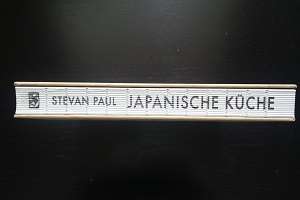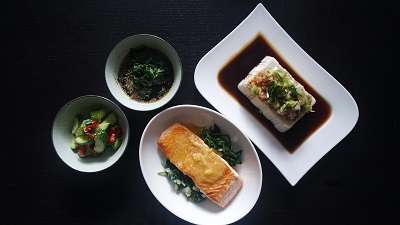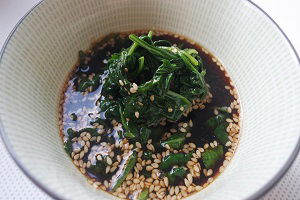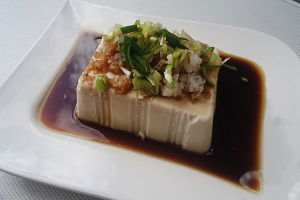Table of contents:
We took a closer look at the Japanese cookbook My Japanese Cuisine by Stevan Paul , which was published in Japan on August 17, 2017. Hölker Verlag kindly provided us with one of these copies and we want to introduce you to all the special features, facts, and some recipes that this book contains.
The quick overview
| Title | My Japanese Cuisine |
|---|---|
| Author | Stevan Paul |
| Genre | Cookbook |
| Specialty | Japanese Cuisine |
| Number of recipes | 80 |
| Of which original creations | 28 |
| Pages | 224 |
| Quality | high-quality processing |
| Special features | Very illustrative traditional recipes and original creations |
| Price | 32.00 € |
First impression

The first impression of the book was a very beautiful experience for both the eye and the hands. The approximately 1.2 kilogram heavy book slipped out of the package with a very nice exterior design. The book cover encloses the book with a beautiful wood look. With the help of a slight roughness, the reader is given the feeling of touching real wood. The open spine shows a beautiful book binding that optimally complements the book design. Upon first inspection, this Japanese cookbook makes a very high-quality impression.
Detailed impression
Looking closer, the book looks even nicer. The thick pages and the recipe photos make quite an impression. Here you can see that this cookbook is not Stevan Paul's first cookbook. With a small team, beautiful pictures, many recipes and small stories have been created. The photos look very harmonious and have been shot very professionally. The perspective from which the photos were taken creates a uniform and clean design. The lighting conditions and the backgrounds are also consistent. All these properties create a comfortable reading experience for the reader. We looked at the beautiful photos for a long time. The first and detailed impression definitely convinced us. Now let's move on to the content.
How does it read?
The book takes the reader directly into Japanese cuisine. With the help of a detailed list of Japanese basic ingredients Stevan Paul makes it easy for beginners to get started.
Before each new chapter, better recipe category, a mostly two-page information text or a story with experiences and impressions of the author leads to the respective chapter topic. On the last pages, Stevan explains Japanese alcoholic drinks like sake & Co. Here, among other things, he gives tips on which drinks complement which Japanese dish.
The recipes are introduced with a short introductory text. The preparation steps are in text form and without a numerical list. Some readers may find this more strenuous than a simple list (like in our recipes).
The recipes
The cookbook consists of 80 recipes from traditional Japanese cuisine and original creations by author Stevan Paul. In addition to traditional recipes such as Tamagoyaki and Miso Shiru the author has also incorporated original creations. These are discreetly marked. The creations are adapted to Japanese cuisine, i.e. they contain Japanese ingredients and are based on this cuisine. The extensive book divides all the recipes into the following recipe categories.
The recipe categories
- Dashi, Miso & Ramen noodle soups
- Sushi and Sashimi
- Tempura
- The Japanese grill
- Izakaya & Family cuisine
- Japanese Vegetarian
- Sweet Japan
We cooked

But what is a review without actually trying out the recipes. We only chose 4 out of the 80 recipes that we thought were suitable and cooked them at the same time. We just like having several side dishes served at once. One of them is one of Stevan Paul's original creations and the other 3 dishes, rather side dishes, perfectly complemented the main dish.
An original creation by the author

This original creation is based on Japanese cuisine and tastes very good. Here, salmon is pan-fried and refined in terms of taste with various vegetables and an exciting dressing of butter and miso. If the salmon is pan-fried perfectly, then this dish is a real treat. We are very convinced of this recipe and it reflects the author Stevan Paul's years of experience.
Cook it right now!
To the recipe suggestion Salmon with miso butter
A typical Japanese salad with spinach

Admittedly, this recipe is a widely used recipe that is very easy to find on the internet. Nevertheless, such side dishes are individualized by the cook and we think that Stevan Paul has brought his own tasty touch to it. However, we found that the quantities given for this recipe (ratio of spinach to dressing) were not optimally laid out. We mixed too much dressing for too little spinach. Therefore, we have adjusted the quantities slightly in our opinion.
Cook it right now!
To the recipe suggestion Ohitashi cucumber salad
The classic cucumber salad

There's only one thing to say here: Very delicious. Fans of Japanese cuisine know this recipe and it shouldn't be missing from any Japanese cookbook. Due to the variety of Japanese cuisine, such simple and delicious recipes can often be forgotten. We think it's good that Stevan Paul devotes a few pages in the book to such small and noteworthy side dishes.
Cook it right now!
To the recipe suggestion Asaduke cucumber salad
The cool tofu refreshment

Tofu is part of Japanese cuisine like schnitzel is part of German cuisine. On the other hand, tofu is much healthier and particularly light. Tofu provides a lot of vegetable protein and serves as an ideal side dish. But be careful! In this recipe, the tofu is eaten raw and for this only silk tofu is suitable. Silk tofu is given in the recipe, but the distinction between the tofu varieties is unfortunately not in the book. For beginners, it can be difficult to find the right type of tofu despite the labeling of the tofu varieties (often in English). With other tofu varieties (soft, firm, pressed, seasoned, etc. tofu), this dish will not taste good. But if the right type of tofu is found (silk tofu also silk tofu), you will experience a tasty refreshment that goes perfectly with warm dishes. The light soy flavor complements many spicy, fatty and sweet dishes. We did not prepare this recipe with all the ingredients listed (including 1 mandarin and 1 lime). We also noticed the large amount of dressing/sauce in this recipe. Because we used a larger piece of tofu and needed less dressing than stated. The recipe yields about 250 ml of dressing/sauce for 280 gr of tofu. We got more than enough with a 400 gr piece of tofu with 125 ml of dressing. It is possible that the large quantity is also intended for additional drinking, but this is not mentioned.
Cook it right now!
To the recipe suggestion Silk tofu with soy sauce
Criticism
The author describes the basic Japanese ingredients in great detail and gives the reader a very good overview. We wonder why tofu didn't appear in the basic ingredients. Tofu is an important ingredient in Japanese cuisine. We believe that a distinction between the tofu varieties is important, because it can be difficult for beginners to find the right tofu. But it remains to be said that the ingredients list contains the type of tofu that is specified, but the description and distinction is not present. We only cooked 4 recipes and were very impressed with all the suggestions. The taste of all the dishes was very good and we will definitely try out more recipes. However, we have picked out 2 recipes where we think too much dressing was stirred in. We particularly noticed the large quantities with the tofu. The quantity can be adjusted in the subsequent 2nd attempt and is therefore not a major criticism.
Our conclusion
We are very impressed with this book. The quality of the book and its content are very high quality . Fans of Japanese cuisine should definitely decorate their bookshelf with this chic cookbook. The many recipes will have you spending countless hours in the kitchen and the detailed information and the author's interesting stories will entertain you even outside the kitchen. The approximately 28 original creations cannot be found on the internet and can therefore only be found in this book (with the exception of the Salmon with miso butter :D). We think the price of €32 is justified by the quality and the visible effort. We give our clear recommendation to buy. The book can be found, among other things, here via Amazon.
Buy My Japanese Cuisine (Affiliate Link)


Comments